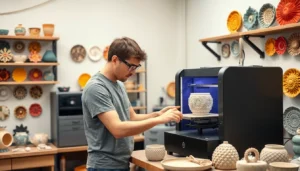Table of Contents
ToggleIn a world where waiting for a package feels like a lifetime, additive manufacturing—better known as 3D printing—is shaking things up. Imagine pressing a button and watching your ideas materialize right before your eyes. It’s like magic, but without the top hat and rabbit. This revolutionary technology’s not just for techies or hobbyists; it’s transforming industries from healthcare to aerospace, making production faster, cheaper, and a whole lot cooler.
Overview of Additive Manufacturing 3D Printing
Additive manufacturing, commonly known as 3D printing, revolutionizes production processes by creating objects layer by layer. This technology utilizes digital models to enable the creation of complex designs that traditional methods struggle to accomplish. With materials such as plastic, metal, and ceramics, 3D printing accommodates various applications, from prototypes to end-use products.
In healthcare, for example, 3D printing facilitates the creation of customized implants and prosthetics, enhancing patient outcomes. Aerospace industries benefit by producing lightweight components, which improve fuel efficiency and performance. Speed and cost savings remain key advantages, as additive manufacturing reduces waste compared to subtractive methods.
Various types of 3D printing technologies exist, each suited for specific applications. Fused deposition modeling (FDM) is popular for its accessibility and ease of use, while selective laser sintering (SLS) excels in producing durable parts. The diversity of methods allows industries to choose the best process for their needs.
Accessibility to 3D printing resources is expanding, making it easier for businesses to adopt this technology. Small businesses can now leverage desktop printers, whereas larger manufacturers utilize industrial-grade machines for mass production. As more users integrate 3D printing into their workflows, innovation and creativity flourish.
The future of additive manufacturing holds promising advancements. Emerging technologies might enhance material properties and reduce printing times. As industries continue to explore new possibilities, the potential applications of additive manufacturing are limitless. Each advancement paves the way for improved products and processes across multiple sectors.
Key Technologies in Additive Manufacturing
Additive manufacturing encompasses several key technologies, each offering distinct advantages and applications in various industries. Understanding these technologies enhances the ability to leverage their potential effectively.
Fused Deposition Modeling (FDM)
Fused deposition modeling represents one of the most widely used 3D printing techniques. It employs thermoplastic materials, feeding filament through a heated nozzle that melts it and deposits it layer by layer. The process is known for its simplicity and cost-effectiveness, making it ideal for prototyping and production of functional parts. Typical materials include PLA and ABS, which cater to different properties like strength and flexibility. Additionally, FDM printers support a wide range of desktop models, appealing to hobbyists and professionals alike.
Stereolithography (SLA)
Stereolithography stands out for its use of photopolymer resins cured by UV light. This technology enables the creation of highly detailed and smooth surface finishes, ideal for intricate designs requiring precision. SLA printers utilize a vat of resin, where a laser draws each layer, making the process slower but highly accurate. Industries often use SLA for dental applications and jewelry production due to its ability to produce complex geometries. Moreover, post-processing is essential, as prints typically require washing and curing to achieve optimal strength.
Selective Laser Sintering (SLS)
Selective laser sintering utilizes powdered materials and a laser that selectively fuses them together, layer by layer. The process accommodates a variety of materials, including nylon, metal, and ceramics, yielding robust parts suitable for end-use applications. SLS is especially favored in aerospace and automotive sectors due to its durability and ability to create lightweight components. No support structures are required, as unsintered powder acts as a support medium, streamlining post-processing. This technology thrives in creating functional prototypes and production parts, demonstrating versatility in additive manufacturing.
Applications of Additive Manufacturing 3D Printing
Additive manufacturing finds versatile applications across multiple industries, showcasing its ability to innovate and streamline production processes.
Aerospace Industry
Additive manufacturing plays a critical role in the aerospace industry. It allows for the production of lightweight components, which enhance fuel efficiency in aircraft. Manufacturers use selective laser sintering to create complex geometries that would be impossible with traditional methods. Customization becomes easier as design changes can be implemented swiftly, saving time and costs. Engine components and brackets produced through 3D printing contribute to weight reduction, directly impacting overall aircraft performance.
Medical Field
The medical field benefits significantly from additive manufacturing technology. Surgeons utilize 3D printing for creating customized implants and prosthetics tailored to individual patients. This technology enables the rapid production of anatomical models for pre-surgical planning, enhancing precision in complex procedures. Furthermore, bioprinting shows promise for developing tissue and organ models, potentially revolutionizing transplant methods. Customized surgical tools also reduce operational risks and improve patient outcomes, aligning with the industry’s focus on personalized healthcare.
Automotive Sector
In the automotive sector, additive manufacturing accelerates prototyping and production processes. Designers create intricate parts faster than conventional methods can manage, resulting in shorter time-to-market cycles. Manufacturers use fused deposition modeling to produce functional prototypes, allowing for real-time testing and modifications. 3D printing supports the production of lightweight components, improving vehicle efficiency and performance. The ability to produce small batches on demand reduces inventory costs, streamlining operations and providing an edge in a competitive market.
Advantages of Additive Manufacturing
Additive manufacturing offers significant advantages, enhancing production processes and expanding design possibilities.
Design Flexibility
Design flexibility stands out as one of the key benefits of additive manufacturing. Complex geometries, previously impossible with traditional methods, become achievable with 3D printing. Layer-by-layer fabrication enables intricate designs, allowing for optimal functionality and aesthetics. Customized products, from medical implants to unique consumer goods, can be created rapidly without altering production setups. Rapid prototyping further supports innovation, as designers can quickly iterate and test concepts, receiving immediate feedback. This flexibility fosters creativity, motivating engineers and designers to push the boundaries of what’s possible.
Cost Efficiency
Cost efficiency is a compelling advantage of additive manufacturing. Reducing material waste significantly benefits manufacturers; traditional methods often create excess that gets discarded. In contrast, 3D printing uses only the necessary material, cutting costs effectively. Labor expenses decrease as automated processes take over intricate tasks, streamlining production. Small production runs become financially viable, allowing companies to produce items without incurring high upfront costs. Overall, this efficiency leads to shorter lead times and more competitive pricing in the market, delivering value to consumers while maintaining quality standards.
Challenges in Additive Manufacturing
Additive manufacturing presents various challenges that impact its full adoption across industries. These challenges encompass material limitations and regulatory issues, affecting production capabilities and market entry.
Material Limitations
Materials used in 3D printing often limit application versatility. While plastics, metals, and ceramics have robust properties, availability may not meet specific requirements for all industries. Each material has unique properties like strength, flexibility, and thermal resistance, which restrict options for certain applications. Current materials also face challenges regarding durability and performance under extreme conditions. Moreover, developing new materials with enhanced characteristics requires substantial research and investment. As advancements occur, addressing these limitations is crucial for expanding the potential of additive manufacturing.
Regulatory Issues
Navigating regulatory frameworks poses significant challenges for additive manufacturing. Different industries, such as healthcare and aerospace, enforce strict standards to ensure product safety and compliance. Approval processes can become lengthy and complex, delaying time to market for new products. Certification of 3D-printed parts often includes rigorous testing, adding costs and extending development timelines. Staying informed about evolving regulations in various regions can prove difficult for manufacturers. Companies must invest resources in compliance to maintain competitive advantages while ensuring product safety and reliability.
Additive manufacturing is reshaping the landscape of production across various sectors. Its ability to create complex designs and customized products is driving innovation and efficiency. As accessibility to 3D printing technology continues to grow, both small businesses and large manufacturers are poised to benefit from its advantages.
While challenges remain in material properties and regulatory compliance, ongoing advancements promise to enhance the capabilities of 3D printing. The future holds immense potential for this transformative technology, paving the way for new applications and improved processes that will redefine how products are made.






